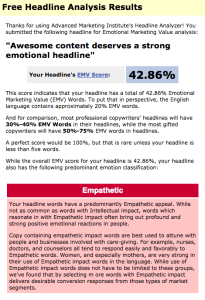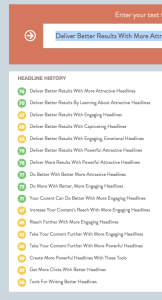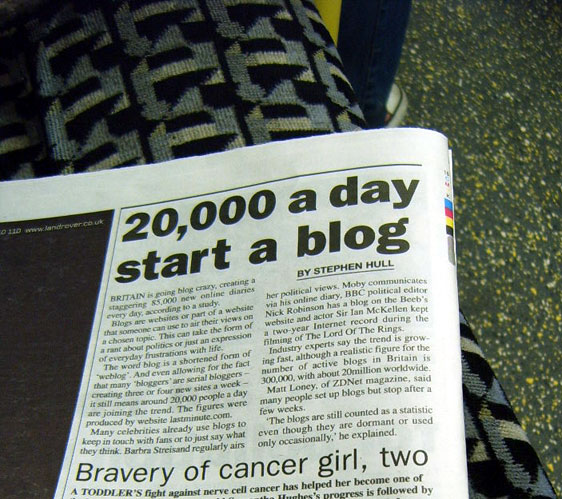I used to really dread writing headlines for blog posts, and was really bad at it. I lacked the right tools for the job and was lost on how to improve. What I didn’t know is that just like making plugins, there are tools that when used right can improve what you create.
I did a little reading, found a few good tools and since then I’ve seen really positive results in terms of shares, traffics and leads.
Last week I wrote about content marketing using WordPress. Content marketing is a great strategy that works by providing something of value — the content — for free. That investment is worth it when the people who need that content are the same people who need your products or services.
But great, well targeted content is meaningless if no one ever reads it. That battle isn’t just about getting links to your content in front of the right people, via social media, or SEO, but making sure you have the right title to motivate people to click on and share your content.
Your titles need to be not just descriptive, but trigger an emotional response that will get readers hooked before they read another line. Just don’t forget that the difference between a quality clickable link and link bait is honesty.
Tools For Creating Great Headlines
Like most things content marketing, Copyblogger has an excellent set of eBooks for learning to master the art of headline writing. There are several tools out there for writing good quality headlines. I uses two of them on every headline I write.
 The first is the EMV Headline Analyzer. I heard about it from Syed Balkhi in his excellent WordCamp Orlando talk, which is really worth watching on YouTube. I immediately put the EMV Headline Analyzer to use optimizing my headlines for my weekly contributions to Torque, and soon start receiving regular compliments from my editor on the amount of traffic my article were generating.
The first is the EMV Headline Analyzer. I heard about it from Syed Balkhi in his excellent WordCamp Orlando talk, which is really worth watching on YouTube. I immediately put the EMV Headline Analyzer to use optimizing my headlines for my weekly contributions to Torque, and soon start receiving regular compliments from my editor on the amount of traffic my article were generating.
Lots of factors contribute to traffic. I’m sure that better headlines had a lot to do with the increase as Torque has always had good social reach for their content, but rely heavily on headlines to generate clicks.
This headline analyzer looks at the emotional content of your headline and scores it from 0 to 100%. Writing your headlines to maximize their emotional impact makes a lot of sense, as we are primarily driven by emotion. Not only are emotional appeals more powerful than logical appeals, headlines are about convincing someone to click them. In 100 characters or less there is little time for a logical argument.
The other headline analyzer I used is CoSchedule’s Headline Analyzer. This tool gives you a lot more metrics than the EMV Headline Analyzer. It also takes into account SEO, readability and uniqueness. More importantly it gives you a detailed analysis of what is good and bad about your headlines, so you’re not just guessing blindly on how to improve a low score.
Don’t Trust The Algorithm Blindly
 As you can see in this screenshot, which shows the scores for the different headlines I tried before finding one I liked, I actually got a bunch of really good scores in a row, but kept going. My scores dipped down for a while before going back up and finding a high scoring and readable headline.
As you can see in this screenshot, which shows the scores for the different headlines I tried before finding one I liked, I actually got a bunch of really good scores in a row, but kept going. My scores dipped down for a while before going back up and finding a high scoring and readable headline.
My final choice for the headline didn’t score as well as what I had earlier. The highest scoring headline was “Do Better With Better More Attractive Headlines” which I rejected as it doesn’t read well. At that point I was trying too hard to game the system and not thinking like a reader.
Working logically to drive up my scores was useful, but it was necessary to step back and find something that actually sounded nice. I’m a huge science-fiction fan, so my life has been full of reminders that algorithms are approximations, not replacements for human judgement and emotion.
You Need More Than One Title
In my last article on content marketing I wrote about using tools like HootSuite or Buffer to share your content more than once. These tools allow you to get more life out of your content by sharing your posts repeatedly, at at an optimized time via social media.
When you use the analytics they provide, you can also use them as A/B testing tools for headlines. It’s not a totally controlled experiment, but using a post’s title and an alternate title for a tweet can be a great indicator of which one was best.
If you are paying to increase the reach of your content on social media, than doing this is a no-brainer as you can send the same message, at the same time, with two different headlines and see which one does best. Then you can refine which one did best, or choose which one to use by demographic in the future.
Also, don’t forget that when sharing posts via social media, especially on networks like Facebook that let you use a longer message then Twitter, often times a pull quote is more effective than a headline.
Even on Twitter, a great pullquote of about 75 words, if can create a more clickable message.
It’s About The Wizard, Not The Wand
I put a lot of thought into the t ools I use to do my job. I swear by the IDE I used to write code, the french press I use to make coffee, the dependency management systems I use, etc. I was happy to find out that for improving my headlines, it was a matter of finding the right tool.
ools I use to do my job. I swear by the IDE I used to write code, the french press I use to make coffee, the dependency management systems I use, etc. I was happy to find out that for improving my headlines, it was a matter of finding the right tool.
That said, keep in mind that all the best tools in the world don’t make you any good at something. Tools help, but without research, education, practice and testing they are not enough. That is true for most things, including headline writing.
Featured image by Photo (c) Annie Mole CC BY 2.0 https://www.flickr.com/photos/anniemole/85515856/

Thanks Josh. Very useful tips. I like that you pointed out the fact that the tools shouldn’t be followed blindly-that the human aspect can’t be overlooked
Kakoma –
Exactly. Gaming the system is fun, and can be useful at times, say for improving search engine rankings. At the end of the day none of that matters if your content is worthless to real people or reaches the wrong audience.
For example, look at this: http://imgur.com/bRY1Yec I got 7 favorites and two list adds from bots for a nonsense tweet by mentioning growth hacking. Does it benefit me in anyway that I triggered all those bots? No, but it makes me think I need to come up with a way to legitimately write about WordPress + Growth Hacking.
Take care,
Josh